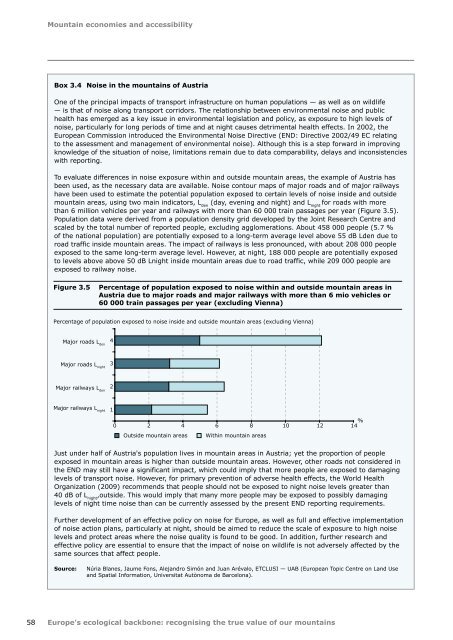Europes ecological backbone.pdf
Europes ecological backbone.pdf
Europes ecological backbone.pdf
You also want an ePaper? Increase the reach of your titles
YUMPU automatically turns print PDFs into web optimized ePapers that Google loves.
Mountain economies and accessibility<br />
Box 3.4 Noise in the mountains of Austria<br />
One of the principal impacts of transport infrastructure on human populations — as well as on wildlife<br />
— is that of noise along transport corridors. The relationship between environmental noise and public<br />
health has emerged as a key issue in environmental legislation and policy, as exposure to high levels of<br />
noise, particularly for long periods of time and at night causes detrimental health effects. In 2002, the<br />
European Commission introduced the Environmental Noise Directive (END: Directive 2002/49 EC relating<br />
to the assessment and management of environmental noise). Although this is a step forward in improving<br />
knowledge of the situation of noise, limitations remain due to data comparability, delays and inconsistencies<br />
with reporting.<br />
To evaluate differences in noise exposure within and outside mountain areas, the example of Austria has<br />
been used, as the necessary data are available. Noise contour maps of major roads and of major railways<br />
have been used to estimate the potential population exposed to certain levels of noise inside and outside<br />
mountain areas, using two main indicators, L den<br />
(day, evening and night) and L night<br />
for roads with more<br />
than 6 million vehicles per year and railways with more than 60 000 train passages per year (Figure 3.5).<br />
Population data were derived from a population density grid developed by the Joint Research Centre and<br />
scaled by the total number of reported people, excluding agglomerations. About 458 000 people (5.7 %<br />
of the national population) are potentially exposed to a long-term average level above 55 dB Lden due to<br />
road traffic inside mountain areas. The impact of railways is less pronounced, with about 208 000 people<br />
exposed to the same long-term average level. However, at night, 188 000 people are potentially exposed<br />
to levels above above 50 dB Lnight inside mountain areas due to road traffic, while 209 000 people are<br />
exposed to railway noise.<br />
Figure 3.5<br />
Percentage of population exposed to noise within and outside mountain areas in<br />
Austria due to major roads and major railways with more than 6 mio vehicles or<br />
60 000 train passages per year (excluding Vienna)<br />
Percentage of population exposed to noise inside and outside mountain areas (excluding Vienna)<br />
Major roads L den<br />
4<br />
Major roads L night<br />
3<br />
Major railways L 2<br />
den<br />
%<br />
Major railways L night<br />
1<br />
0 2 4 6 8 10 12 14<br />
Outside mountain areas<br />
Within mountain areas<br />
Just under half of Austria's population lives in mountain areas in Austria; yet the proportion of people<br />
exposed in mountain areas is higher than outside mountain areas. However, other roads not considered in<br />
the END may still have a significant impact, which could imply that more people are exposed to damaging<br />
levels of transport noise. However, for primary prevention of adverse health effects, the World Health<br />
Organization (2009) recommends that people should not be exposed to night noise levels greater than<br />
40 dB of L night<br />
,outside. This would imply that many more people may be exposed to possibly damaging<br />
levels of night time noise than can be currently assessed by the present END reporting requirements.<br />
Further development of an effective policy on noise for Europe, as well as full and effective implementation<br />
of noise action plans, particularly at night, should be aimed to reduce the scale of exposure to high noise<br />
levels and protect areas where the noise quality is found to be good. In addition, further research and<br />
effective policy are essential to ensure that the impact of noise on wildlife is not adversely affected by the<br />
same sources that affect people.<br />
Source:<br />
Núria Blanes, Jaume Fons, Alejandro Simón and Juan Arévalo, ETCLUSI — UAB (European Topic Centre on Land Use<br />
and Spatial Information, Universitat Autònoma de Barcelona).<br />
58 Europe's <strong>ecological</strong> <strong>backbone</strong>: recognising the true value of our mountains

















